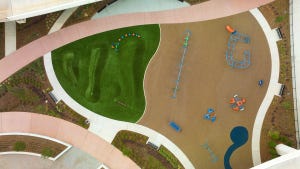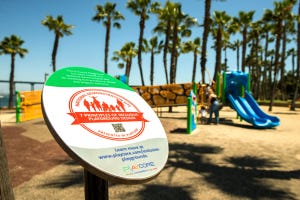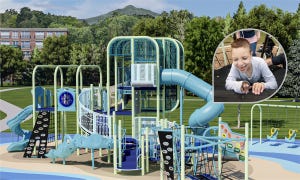Play for Every Age and Ability
This blog post includes excerpts from the article Widening the Playing Field, originally published in the October 2017 issue of Recreation Management magazine.
Creating a Space for Everyone
Multigenerational playgrounds have been around in one form or another in the United States since the 1950s, but trying to appeal these days to a modern, diverse American audience all at once can be a challenging task. Tots, teens, gen Z, millennials, gen Xers and baby boomers each have generational characteristics. They gravitate toward several distinct relaxation styles and exercise techniques and are drawn to different play equipment.
Historically, when a family goes to a play space, the preteen/teenage members would be completely absent. Parents headed for the bench, kids went to the play area and except for brief interchanges, they would remain in these spaces until it was time to go.
"Multigenerational playgrounds have been around in one form or another in the United States since the 1950s."
"I think that owners of public spaces and equipment manufacturers are just beginning to really comprehend what that means to a family, and now they are responding with meaningful designs," explained Anne-Marie Spencer, corporate vice president of marketing for PlayCore. "The trick to really engaging the entire family is creating a space with opportunities for activity that appeal to the whole family, as opposed to someone taking part in something they don't really enjoy, just to play along."
Universal Design, Inclusion and Accessibility
Another thing that is becoming common in park design is universal design or inclusive playgrounds. Universal design is a set of principles and an approach to creating environments that are more fun and functional for a wider range of users, regardless of age or ability.
Taking that concept one step further is Kent Callison, director of marketing for GameTime. Accessibility in playgrounds has heretofore meant ensuring that a play environment was accessible by children with a physical disability. "This is important, and it is required by DOJ Accessibility Guidelines for public parks and play spaces," Callison said, "but access alone does not guarantee inclusion. Truly inclusive play includes access, but it also considers a much wider range of needs—beyond physical disability."
Out of 1,000 children between the ages of three and 21, approximately 85 will have some type of disability, Callison explained. "For example, one of those children will have a physical disability and 41 will have a cognitive disability."
But numbers like one or 41, or even 85 out of 1,000 don't really give a full picture of the population of children affected by a disability. According to the U.S. Department of Education, there are approximately 6.6 million children in the United States who are affected by some type of disability (physical, sensory, chronic health condition, social-emotional, communication, cognitive).
"To put all that into perspective," Callison said, "the entire population of the state of Tennessee is 6.6 million people. That's an entire state's population worth of children who could benefit from truly inclusive play spaces."
"Truly inclusive play includes access, but it also considers a much wider range of needs—beyond physical disability."
What makes a play space inclusive, Callison said, is creating a space that addresses the needs of those 6.6 million children, as well as every other child in the country. The idea is to create a space that allows every child to play together, and to participate fully in a variety of activities in a mutually beneficial way. And while the primary audience of a play area is children, an inclusive play space should be a multigenerational environment that allows people of all ages and abilities to play and recreate with friends and families."
Callison's manufacturing company uses design guidelines found in "Me2: The 7 Principles of Inclusive Playground Design," created in partnership with Utah State University Center for Person with Disabilities. "It's a guidebook of best practices and considerations for upgrading existing or designing new outdoor inclusive play environments."
"...there are approximately 6.6 million children in the United States who are affected by some type of disability..."
Callison then noted four products that aligned with their corporate philosophy: a climber that provides auditory, tactical and visual feedback while children climb, play and explore, with three sensors featuring technology that allows individuals with limited upper-body or fine-motor control the ability to activate auditory features; a freestanding motion activity featuring a high-back molded seat with handles and front pommel, allowing children to maintain a neutral body position while spinning; a patented double-wide playground ramp that transforms an ordinary accessible ramp into a play experience for all children; and a collection of precision-tuned musical instruments.
By designing a play space to align with best practices, Callison said, "and selecting playground equipment that addresses the needs, and provides developmental benefits for children of all abilities, you create a play environment that is truly inclusive."





